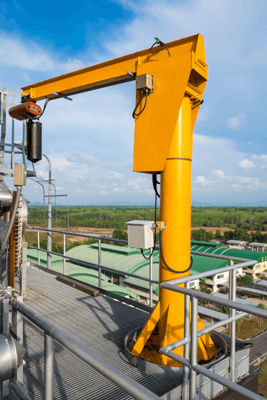What Is a Jib Crane?

A jib crane is a crane with a jib.
The arm fittings protruding diagonally from the crane are called a jib. A jib crane is designed so that the jib can be swung and retracted. A jib crane is capable of moving a suspended load in three dimensions by means of jib motion and wire hoisting.
A jib crane with a lifting load of 0.5t or more is likely regulated by local laws. Specific details are stipulated, and periodic performance inspections and voluntary inspections must be conducted for jib cranes.
Uses of Jib Cranes
Jib cranes are widely used in industrial applications and heavy industries. The following are some examples of jib crane applications:
- For unloading raw materials or shipping products in steel mills and smelters.
- Container loading and unloading on container ships.
- For maintenance of large vessels.
- For loading and unloading materials at construction sites.
- For loading/unloading raw materials to/from warehouses.
In most cases, quay unloading cranes are rigidly fixed to the quay. This is because they are stronger and can carry a higher lifting load.
Jib cranes with traveling movements are also used for loading and unloading and for ship maintenance. In the case of cranes with traveling functions, electric power is supplied by robot cables or other means.
Principle of Jib Cranes
Jib cranes consist of a mounting base, jib, drive unit, and wire rope.
The mounting base is the foundation on which the jib cranes are installed. The jib crane itself is heavy and carries a load of several tons or more, so the strength of the foundation is important. The foundation is made by pouring concrete, and in the case of a self-propelled type, strong rails are laid on top of it.
The jib is the arming portion of the crane and must be both sturdy and lightweight. Therefore, it is usually reinforced by a box structure or pipe truss structure.
The drive unit drives the crane and consists of a reduction gear and motor. In the case of the hoisting equipment, a wire rope is wound around a wire drum to raise or lower a suspended load.
Types of Jib Cranes
Jib cranes are classified into several types according to their structures. The following are some of the types of jib cranes:
1. Low Floor Jib Cranes
These are jib cranes with the crane mounted on a fixed slewing rail. These cranes are often used for loading and unloading at wharves, and in the case of traveling type, the slewing rail is mounted on a cart.
2. Vertical Jib Cranes
Jib cranes are cranes with a horizontal jib mounted on a post installed on the ground. Since the jib is horizontal, rails may be installed and a hoist may be attached. These cranes are used in a wide range of situations, such as construction sites and wharves.
3. Tower Jib Cranes
Tower jib cranes are jib cranes with a jib attached to a tower-shaped structure. It is characterized by its ability to transport suspended loads from high places. They are mainly used in shipyards.
4. Retractable Jib Cranes
General jib cranes are operated by lifting the jib, which causes the load to move up and down during retrieval. Retractable jib cranes have a structure that allows the crane to retract the load horizontally. They are mainly used at docks to unload powder loads.
Other Information About Jib Cranes
1. Operation of a Jib Crane
Jib cranes are characterized by their ability to perform three movements: slewing, retracting, and hoisting.
The slewing motion is a 360° rotation of the jib about the crane’s central axis. When used for unloading cargo at the wharf, the crane is swung while the cargo is suspended to transport the cargo from the ship to land. The turning motion is mainly powered by a motor with a reduction gear or a hydraulic pump and is performed gently to avoid excessive impact due to the heavy loads being handled.
The retracting motion moves the load closer to or further away from the center axis of the crane. Typical jib cranes perform the retracting action by lifting or pulling down the jib.
The hoisting operation raises or lowers the load by hoisting or lowering the wire. Because it actually raises and lowers the load, it requires the most power of all jib cranes.